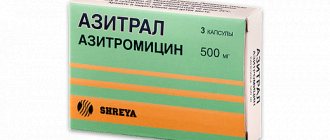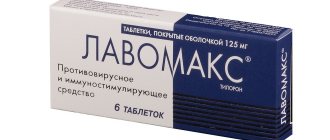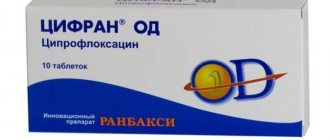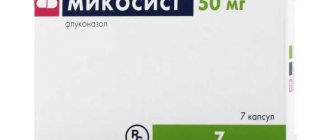Magnesium is a mineral element important for the heart muscle, bone tissue, liver and kidneys. The human body contains about 25 grams of the substance. Men should receive 350 mg of the mineral per day, women – 300 mg, pregnant women – 920 mg, nursing mothers – 1250 mg. Magnesium ensures cellular growth, normal functioning of the heart and nervous system, participates in the formation of protein structures, phosphorus metabolism, removes toxins from the body, and regulates the concentration of cholesterol in the blood. To prevent and treat pathologies caused by magnesium deficiency, it is recommended to use the drug Magne B6, sold in ampoules and tablets.
Compound
Magne B6 tablets contain magnesium lactate dihydrate at a concentration of 470 mg/tablet. (equivalent to 48 grams of Mg++), vitamin B6 (pyridoxine hydrochloride) content - 5 mg.
Heavy kaolin, carboxypolymethylene, sucrose, magnesium in the form of hydrosilicate (talc) and stearate, and acacia gum are used as auxiliary components.
Tablet shell composition: acacia gum, sucrose, titanium dioxide, trace amounts of magnesium hydrosilicate and carnauba wax in powder form.
The oral solution contains 186 mg of magnesium lactate dihydrate and 936 mg of magnesium pidolate (which corresponds to a total Mg++ content of 100 mg), 10 mg of pyridoxine hydrochloride.
Auxiliary components: sodium disulfite and saccharinate, cherry and caramel flavoring, purified water.
Composition of Magnesium B6 Forte (Antistress) tablet: 618.43 mg magnesium citrate, 10 mg pyridoxine hydrochloride, anhydrous lactose, magnesium stearate and hydrosilicate, macrogol 6000, hypromellose, titanium dioxide.
Release form
Pharmacological forms of the drug:
- biconvex oval tablets in a white film shell with a shiny smooth surface (10 pieces in aluminum foil and PVC blisters, 5 blisters per package);
- a transparent, brown solution for oral use with a distinct caramel odor (in 10 ml ampoules, 10 ampoules in a cardboard packaging insert);
- white oval biconvex film-coated tablets (15 pieces in blisters made of aluminum foil and PVC-PE-PVDC, 2 or 4 blisters per package).
Pharmacodynamics and pharmacokinetics
Magnesium (Mg) is an important biogenic element, which is present in significant quantities in all tissues of the body, is a cofactor in most metabolic processes and ensures the normal functioning of cells.
In particular, this element is necessary for the biotransformation of creatine phosphate into ATP - nucleoside triphosphate, which plays the role of a universal energy supplier in living cells of the body.
protein cannot be synthesized normally . The element takes part in muscle contraction (including maintaining the normal function of the heart muscle ), regulates the transmission of impulses in nerve fibers , promotes vasodilation , stimulates the secretion of bile , increases the motor activity of the intestinal tract , which in turn helps remove cholesterol from the body.
Magnesium enters the body with food. Its deficiency can be primary (due to hereditary pathologies) or secondary. Secondary magnesium deficiency is usually associated with:
- with a nutritional disorder (diet poor in vitamins and minerals, exclusively parenteral nutrition, chronic alcoholism);
- with an increase in a person’s need for a microelement during intense physical or mental activity, during periods of intense growth, during pregnancy, during stress, excessive losses of Mg through the kidneys (for example, with chronic pyelonephritis , abuse of diuretics , treatment with cisplatin );
- with impaired absorption of Mg in the gastrointestinal tract due to hypoparathyroidism , chronic diarrhea , etc.
Vitamin B6 (pyridoxine) improves metabolic processes, including in brain tissue. As a result, brain performance increases, mood and memory improve.
In addition, the presence of pyridoxine in the composition of Magne B 6 improves the absorption of Mg from the digestive tract and its distribution in the cells of the body.
If the serum concentration of Mg is in the range from 12 to 17 mg/l, they speak of moderate Mg deficiency. An indicator not exceeding 12 mg/l is evidence of severe microelement deficiency.
No more than half of the Mg dose taken orally is absorbed in the digestive tract 99% of the microelement is located in the intracellular space, while about 66% of intracellular Mg is distributed in bone tissue , the remaining amount is in striated and smooth muscles .
Mg is excreted mainly in the urine (about a third of the dose taken).
Impact on the body
Magne B6 is a complex product based on magnesium and pyridoxine (B6).
Magnesium is essential for the normal functioning of many metabolic reactions, maintaining muscle contractility and optimizing the movement of nerve signals. The main suppliers of the mineral to the body are foods, so a deficiency of the substance is observed during strict diets, fasting, and intestinal dysfunction. A person needs increased magnesium consumption during constant stress, intense physical and intellectual work, taking diuretic medications, and bearing a child.
Pyridoxine (B6) is a participant in many metabolic reactions. It supports the full implementation of metabolic processes in nerve fibers. In the preparation, magnesium and pyridoxine are in a complex, since the vitamin helps the mineral to be absorbed in the digestive organs and penetrate into the cells.
Of the taken amount of medicine, only half is absorbed in the intestinal tract; the unused part of the substances leaves the body in the urine.
Contraindications
Contraindications to the use of Magne b6 are:
- severe renal failure (conditions in which creatinine does not exceed 30 ml per minute);
- impaired absorption of glucose and galactose , fructose intolerance, sucrose-isomaltase deficiency (only for the tablet form of the drug);
- simultaneous use of the antiparkinsonian drug levodopa ;
- phenylketonuria;
- hypersensitivity to the substances contained in the tablets/solution.
In pediatrics, tablet forms of the drug are prescribed from the age of six; the solution in ampoules is allowed from the age of one.
Due to the risk of developing hypermagnesemia , the drug should be prescribed with caution to persons with moderate renal failure .
Side effects with contraindications
Why Magnesium B6 is prescribed to children and in what dosages is now clear, but we still have to figure out the contraindications. Sometimes children under 4-5 years of age experience allergic reactions, nausea and vomiting, and may also experience constipation and bloating. This is especially unpleasant in the case of infants up to 9-10 months.
These unpleasant symptoms may appear in the case of renal failure and other disorders, so it is better to trust the prescription of Magnesium B6 to children under 7-10 years of age to good pediatricians.
Complexes containing phosphates and calcium can reduce the absorption of the drug in children. In this regard, they need to be prescribed at a certain interval, otherwise Magnesium and B6 will not have time to be absorbed. The tablets contain sucrose and are therefore not suitable for children with diabetes. In this case, a solution is better (especially for children under 2 years old).
Instructions for Magne B6 (Method and dosage)
Before taking Magne B6, you should consult your doctor. The average course duration is one month. Treatment is stopped immediately after the Mg concentration in the blood is normalized.
The medicine is taken with meals 2 or 3 times a day.
If the drug is prescribed during pregnancy, the dose is selected individually by the attending physician.
Magne B6 tablets: instructions for use
Magne b6 tablets are taken 6-8 pieces per day.
According to the instructions for use for children, the daily dose for patients over 6 years of age (provided that their body weight exceeds 20 kg) is 4 to 6 tablets.
Instructions for Magne B6 in ampoules
Adults are prescribed the solution to take 3-4 ampoules of 10 ml per day. Before administration, the drug is dissolved in 0.5 glasses of drinking water.
For children over 12 months (if their body weight exceeds 10 kg), Magne B6 in ampoules is prescribed to take 10-30 mg of Mg per kilogram of weight (the indicated dose is contained in 1-4 ampoules of the drug).
Instructions for Magne B6 Premium
The tablets are taken with meals. Swallow them whole with a glass of drinking water.
For an adult, the daily dose of Magne B 6 is 3-4 tablets. Children over six years of age (if their weight exceeds 20 kg) should be given 10 to 30 mg/kg/day. (or 2-4 tablets).
Indications for use
Taking Magne B6 is indicated for both therapeutic and prophylactic purposes.
The drug is prescribed to eliminate magnesium deficiency, accompanied by the following pathological conditions:
- tachycardia;
- sleep disorders;
- chronic fatigue;
- muscle spasms;
- painful contractions of the stomach and intestinal walls;
- pain in muscle fibers;
- stabbing sensations in soft tissues;
- nervousness, anxiety.
For preventive purposes, the use of the medication is indicated for pregnant women, people on strict diets, eating poorly, and often exposed to stress. Also, indications for use to prevent magnesium deficiency are kidney inflammation, treatment with diuretics.
Overdose
In patients with normally functioning kidneys, an overdose of magnesium taken orally does not usually cause toxic reactions. In case of kidney failure, excess magnesium can cause poisoning, the symptoms of which are:
- nausea;
- vomit;
- ECG changes;
- decrease in blood pressure;
- hyporeflexia;
- CNS depression;
- disturbances of cardiorespiratory function (up to coma, respiratory paralysis and cardiac arrest);
- anuric syndrome.
The severity of overdose symptoms depends on the concentration of the trace element in the blood.
Treatment involves forced diuresis and rehydration therapy . For renal failure, peritoneal dialysis and hemodialysis are indicated .
Special recommendations for taking magnesium supplements
Taking magnesium and other medications together
Concomitant use of the drug with tetracycline antibiotics or calcium supplements is not recommended. Magnesium interferes with the full absorption of antibiotics, reducing its effectiveness. Calcium, in turn, interferes with the absorption of magnesium. If there is an urgent need to take magnesium along with the listed drugs, you need to ensure that an interval of at least 3 hours is maintained between doses.
Magnesium during pregnancy
Only a doctor can prescribe taking the drug during pregnancy, taking into account the balance of benefit and harm for the expectant mother and fetus. However, the prescription of magnesium during pregnancy is common, because during this period there is most often a deficiency of vital magnesium. It helps relieve uterine hypertonicity, regulate mood and sleep in a pregnant woman against the background of hormonal changes. But magnesium is contraindicated during breastfeeding, since the drug passes into breast milk. So, during the feeding period, magnesium supplements should be discontinued.
Magnesium intake and kidneys
The kidneys play a critical role in magnesium balance. They control the retention and excretion of minerals. Magnesium is not harmful to healthy, normally functioning kidneys. In fact, adequate magnesium levels reduce the risk of cardiovascular and kidney disease. Research has shown that chronic kidney disease causes magnesium depletion, and reduced magnesium levels cause calcification of blood vessels. Therefore, special attention should be paid to the use of magnesium if there are kidney diseases. This results in hypermagnesemia.
Hypermagnesemia
Normally, the human body contains about 70 g of magnesium, of which a large proportion (60%) is in bone tissue, the rest is contained in muscles, soft tissues and liquid media. It is present in large quantities in brain cells and in the heart. An excess of the element provokes an imbalance in the functioning of internal organs.
The reason for this may be insufficient excretion of magnesium in the urine and impaired renal function.
Interaction
Due to the fact that pyridoxine (in any quantities) inhibits the activity of levodopa , it is contraindicated to prescribe this drug in combination with Magne B6. This applies to situations when taking levodopa is not combined with taking drugs that suppress the activity of peripheral decarboxylase of aromatic amino acids existing in the L-form.
It is not recommended to take Magne B6 with drugs that contain Ca salts or phosphates (these drugs impair the absorption of Mg in the intestinal tract).
Since Mg preparations reduce the absorption of tetracyclines , at least a three-hour interval should be maintained between their doses.
Interaction with other medications
Magne B6 weakens the intensity of the therapeutic effect of antiparkinsonian drugs, in particular Levodopa. If joint use of drugs is unavoidable, then taking a drug from the category of decarboxylase inhibitors is additionally indicated.
At the same time as Magne B6, you should not take medications based on calcium and phosphorus salts, as these substances impair the absorption of magnesium in the intestinal tract.
Magnesium inhibits the effect of tetracycline antibiotics, so the interval between doses of Magnesium B6 and antibiotic drugs should be at least 2 hours.
Magnesium inhibits the effectiveness of thrombolytics and anticoagulants and impairs the absorption of iron.
special instructions
Ampoules with Magne B6 solution are self-breaking (each has 2 marking rings and a break line) and does not require the use of a nail file.
To open the ampoule, take it by the tip, having previously covered it with a piece of fabric, and with a sharp movement break it off first from the pointed end, then from the opposite. The end opened first is directed at an angle into a cup of water so that the tip of the ampoule, which is broken off second, is not above the cup.
After the second tip of the ampoule is broken off, the solution will flow freely into the glass.
Patients with diabetes need to remember that film-coated tablets contain sucrose as an excipient. Therefore, the dosage form that is more preferable for them is a solution that does not contain sugar.
In case of malabsorption syndrome (impaired absorption) and severe magnesium deficiency, treatment should begin with intravenous administration of Mg preparations.
If a patient has a concomitant calcium deficiency, the Mg deficiency is corrected before taking dietary supplements or medications that contain Ca.
The solution contains sulfite, a substance that can cause or intensify hypersensitivity reactions, including anaphylactic reactions (especially in patients at risk).
Taking high (exceeding 200 mg/day) doses of pyridoxine for several months/years can cause the development of sensory axonal polyneuropathy , which is manifested by symptoms such as tremor, numbness and disorders of proprioceptive sensitivity of the distal arms and legs, gradually manifesting sensory ataxia ( imbalance).
Disorders of this kind are usually reversible and disappear after stopping taking vitamins.
Analogues of Magne B6
Level 4 ATX code matches:
Magwit
Magne B6 Forte
Vitrum Life
Analogs of Magne B6 are the drugs Magnesium B6 Evalar , Magnelis B6 , Magnikum , Magnistad , Magnefar B6 , Magvit B6 , Beresh Magnesium plus B6 .
The price of analogue tablets is from 150 Russian rubles.
Which is better: Magnelis or Magne B6?
The drug Magnelis B6 is produced by Pharmstandard and, like its analogue Magne B6, is intended to replenish Mg deficiency in the body. The products have a similar composition (Magnelis contains 470 mg Mg lactate and 5 mg pyridoxine , Magna B6 contains 470 mg Mg lactate dihydrate and 5 mg pyridoxine ), the same indications for use and contraindications, and cause similar side effects.
The main differences are the manufacturer and price.
Analogs
Magne B6 has analogs both in composition and in the principle of its effect on the body.
Among the analogues in composition we can note:
- Magnelis B6;
- Magnesium Plus B6;
- Magwit.
There are more substitutes for the action. The following vitamins and medications can be noted:
- Vitrum Osteomag;
- Additive Magnesium;
- Magnerot;
- Magnesium-Diasporal.
Magne B6 for children
Magnesium is very important for children because it participates in various biochemical reactions of the body, improves the absorption of calcium and the tone of the walls of blood vessels, and normalizes the conduction of nerve impulses in the brain.
Magnesium deficiency is very closely related to stress. Experts consider Mg deficiency and stress to be interdependent processes that can aggravate each other.
Both acute and chronic stress lead to depletion of the intracellular Mg pool and its loss in the urine. This is due to the fact that in a stressful situation the body releases more adrenaline and norepinephrine , which contribute to the elimination of Mg from cells.
Magnesium deficiency often leads to a decrease in the ability to concentrate, memory impairment, convulsive seizures , impairment of consciousness and the coordination sphere (usually this manifests itself in the form of nystagmus, ataxia, tremor ). Some children develop paresthesias and increased tendon reflexes .
In children of all ages, Mg deficiency (as well as stress) provokes an increase in blood pressure - one of the significant components of stress and changes the cerebroreactive reactivity of blood vessels towards a constrictor response.
Biochemical and clinical-neuropsychological studies, as well as reviews of Magne B6 for children, confirm that taking Mg drugs can curb the rise in blood pressure, increase stress resistance, improve behavior, memory and attention, normalize sleep, reduce anxiety, the level of synkinesis and aggression.
In accordance with the instructions, in pediatric practice the solution is prescribed from the age of one year, tablets - after 6 years, however, in the presence of neurological disorders, Magne B6 can be used from the first days of life. The dosage for an infant is calculated depending on his body weight.
It is very important that the composition of the drug (both in the form of a solution and in the form of tablets) includes organic Mg salts - lactate, citrate and pidolate - which are characterized by high bioavailability and practically do not cause side effects.
Magne B6 Forte, which is based on Mg citrate, is recommended for use in children with oxalaturia and acidosis , as well as in children with a shift towards acidosis : the drug is used to compensate for rapid nervous and mental exhaustion in patients with a neuroarthritic type of constitution and for the prevention of urolithiasis .
Why are magnesium and B6 important for children?
Magnesium and B6 are incredibly important for all children. Normally, babies should receive the following micronutrients:
- 150 mg magnesium for children under 3 years of age;
- 200 mg – children from 4 to 7 years old;
- 250-300 mg – children over 8 years old.
Magnesium together with B6 in children contributes to the normal functioning of all cells. Substances are needed for numerous metabolic processes occurring at the cellular level. They are especially important for the functioning of the central nervous system and the musculoskeletal system.
In childhood, the nervous system is just forming and improving, so any doctor will tell you why children need magnesium and B6. Without them, the child will not develop as quickly as he should.
Magne B6 during pregnancy
Why Magne B6 during pregnancy?
Magne b6 is prescribed quite often during pregnancy. It is advisable to use the drug in pregnant women when:
- hypertonicity of the uterine muscles threatening spontaneous miscarriage ;
- Mg deficiency confirmed by test results .
Clinical experience with the use of Mg preparations and doctors’ reviews of Magne B6 indicate that prescribing the drug for uterine hypertonicity allows you to quickly and effectively calm the nervous system, as well as relieve spasms and tension in the muscles.
The main reason for the increased tone of the uterine muscles is the calcium contained in the muscle fibers. Mg has the ability to reduce its amount and thereby promote muscle relaxation.
During the period of bearing a child, the female body requires more magnesium than usual. If the microelement is not supplied to it from the outside in the required doses, the fetus begins to draw Mg from the mother’s body, which significantly affects the health and well-being of the pregnant woman. Once the mother's Mg reserves are depleted, the condition of the fetus will also begin to deteriorate.
Magnesium deficiency causes poor development of blood vessels in the placenta, which leads to malnutrition of the fetus and the threat of miscarriage.
Contraindications
The instructions for the drug indicate that contraindications to its use are fructose intolerance , severe renal failure , allergic reactions to the substances contained in the tablets/solution.
How to take MagneB6 during pregnancy?
The dosage of Magne B6 during pregnancy is usually as follows: 2 tablets with each of the main meals (morning, lunch and evening). Thus, the dose of Magne B 6 for a pregnant woman is 6 tablets per day, and the dosage regimen does not change depending on the stage of pregnancy.
In the 1st and 2nd trimesters, the use of the drug is advisable if there is a threat of miscarriage. In the third trimester, a woman usually experiences an increased feeling of discomfort, night cramps and swelling.
Magnesium deficiency can lead to increased secretion of aldosterone and the development of edema. Delayed removal of fluid from the body, in turn, provokes an increase in blood pressure , which is very dangerous both during pregnancy and during childbirth.
The duration of treatment can range from 2 weeks to 9 months. After childbirth, the drug is stopped, since it tends to penetrate into the milk of a nursing woman.
Reviews from specialists and clinical experience with the use of Magne B6 during pregnancy indicate that the drug does not have an adverse effect on the process of prenatal development or fetotoxic effect. However, the drug can only be used if indicated and only on the recommendation of a doctor.
Magne B6
Magne B6 is a combination drug that includes the macroelement magnesium and pyridoxine (vitamin B6). Without magnesium, the normal functioning of the human body is unthinkable. This macroelement is an active participant in energy and water-salt metabolism, key biosynthetic reactions. Regulates cell growth and is in demand in all phases of the formation of protein molecules. Takes part in phosphorus metabolism, synthesis of high-energy compounds, regulation of glucose breakdown, and bone tissue formation. In addition to the above, magnesium inhibits excitation processes in the central nervous system and increases the body's adaptive abilities to external influences, which allows it to be considered an effective anti-stress factor. The lack of this element is quite common. According to various estimates, it is observed in 25–30% of the population. The main reason is the large amount of refined food in the diet of modern people, as well as the active use of mineral fertilizers, which “wash out” magnesium from the soil. A lack of magnesium can result in cardiovascular, endocrine, and neuropsychiatric pathology. Hidden magnesium deficiency can manifest itself as asthenia, depression, psycho-emotional changes, vertigo, and vegetative-vascular disorders. In this regard, one of the most important tasks of clinical pharmacologists is the creation and implementation of effective and safe tableted magnesium preparations. During their development, the effectiveness of the combination of magnesium with pyridoxine, an important metabolic agent involved in protein metabolism, the synthesis of neurotransmitters, etc., was established. Pyridoxine increases the absorption of magnesium in the gastrointestinal tract, facilitates its transport and promotes accumulation in tissues, enhances the pharmacological effect (shows synergy). Magnesium, for its part, stimulates the activity of pyridoxine in the liver. An example of a combination of magnesium and pyridoxine is Magne B6. The components of the drug complement each other and potentiate each other’s action, effectively preventing magnesium deficiency in the body. About half of the administered dose of the drug is absorbed in the gastrointestinal tract.
Most of the magnesium is accumulated in bone tissue, the rest in smooth and skeletal muscles. Elimination of magnesium from the body is carried out primarily by the kidneys. Taking Magne B6 is advisable for such signs of magnesium deficiency as increased irritability, sleep disorders, spasms of smooth muscles of the gastrointestinal tract, tachycardia, chronic fatigue, tingling in the muscles. Before starting to use the drug, despite its over-the-counter status, you should seek medical advice. The optimal time to take the drug is with meals. Frequency of administration – 2-3 times a day. An indicator of cessation of drug therapy is normalization of plasma magnesium levels. The scope of use of Magne B6 is extremely wide. These are various forms of cardiovascular pathology (hypertension, cardiac failure, cardiac arrhythmias, post-infarction conditions), pathological decrease in bone mineral density, diabetes mellitus, vegetative-vascular dystonia, asthenia, increased fatigue and anxiety, depressive states, headache, somnological disorders, elderly age, pregnancy and increased physical activity. Magne B6 is well tolerated by patients. In extremely rare cases, allergic reactions and dyspepsia are possible. The drug is contraindicated in severe forms of renal failure, individual intolerance, and taking levodopa. In pediatric practice it is used starting from the age of 6 years. Post-marketing studies of the drug in pregnant women demonstrated the absence of undesirable effects on the fetus. However, Magne B6 can be used by pregnant women only in consultation with a doctor. Magnesium is absorbed into breast milk and should be avoided in nursing women. Magne B6 contains the disaccharide sucrose as an auxiliary component, which must be taken into account when prescribing the drug to people suffering from diabetes.
Reviews of Magna B6
Reviews from doctors about Magna B6 are positive: experts consider this remedy to be indispensable in conditions where the patient’s body suffers from magnesium deficiency . It is especially important for children and during pregnancy. In addition, Mg preparations are the core of neurorehabilitation and therapeutic measures for pathologies such as attention deficit in children and hyperactivity.
Prescribing Magne B6 to children - reviews from doctors and mothers confirm this fact - can significantly improve the general condition of the child, reduce his aggressiveness, increase attentiveness, improve behavior, and school performance.
Magne b6 helps to normalize the magnesium balance and, consequently, the physiological processes occurring in the body, in particular, the processes that ensure the normal functioning of the heart, as well as the nervous and vascular systems, creating an optimal background for pharmacotherapy in adults and children.
Since the drug contains Mg in organic form and in an acceptable dosage, its use is usually not associated with side effects.
As an alternative to Magne B6, to correct magnesium deficiency, the patient may be prescribed Magnesium B6 Evalar , Magnistad , Magnelis B6 .
Magnesium for health
Magnesium is an essential trace element that is directly involved in the functioning of the nervous system. Regulates cellular metabolism, ensures the transmission of nerve impulses between muscles and the brain. A sufficient amount of this element in the body helps to more easily endure stress and shock, not experience muscle tone and spasms, and regulate mood and emotions.
Magnesium is extremely important for women's health during pregnancy. Regulates endocrine functions. Magnesium is best absorbed only in combination with vitamin B6 or pyridoxine. Therefore, it is required to be present in magnesium preparations.
The main symptoms of magnesium deficiency in the body:
- headache;
- tachycardia;
- arrhythmia;
- muscle cramps;
- irritability;
- insomnia;
- premenstrual syndrome;
- "lazy bowel" syndrome;
- anxiety and neurasthenic disorders;
- photosensitivity and sensitivity to noise;
- hypertension;
- increased level of platelets in the blood.
Price Magne B6
Cost of the drug in Russian pharmacies
The price of Magne B6 tablets No. 50 is from 280 rubles, the price of Magne B6 in ampoules No. 10 is from 360 rubles.
Price Magne b6 in Ukraine
The average price of tablets No. 50 is 140 UAH; you can buy a solution for about 70 UAH.
Despite the fact that Magne B6 belongs to the category of over-the-counter products, you should consult your doctor before purchasing the drug (especially for children and during pregnancy).
- Online pharmacies in UkraineUkraine









